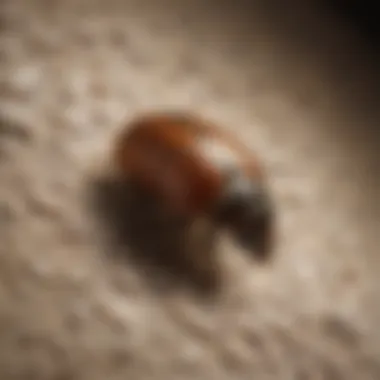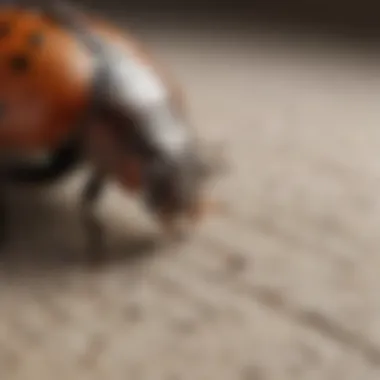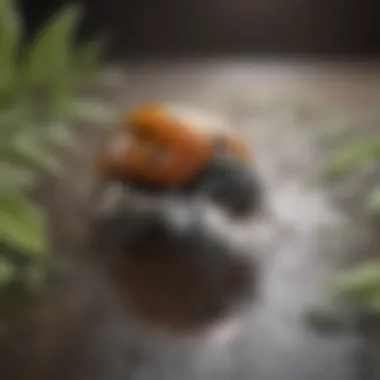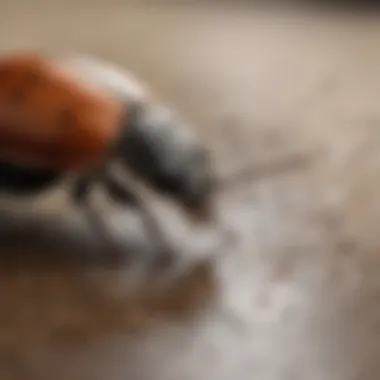Top Insecticides to Eliminate Carpet Beetles


Understanding the Pest
Carpet beetles can be a nuisance in any household. Understanding these pests is the first step in effective management.
Identification
Carpet beetles are often mistaken for other common household insects. The most common species include the varied carpet beetle, black carpet beetle, and furniture carpet beetle. Adult carpet beetles are typically small, about 1/8 to 1/4 inch long. Their coloration can vary, but they often present a mix of black, brown, and yellowish scales on their bodies.
Signs of an infestation include visible larvae which are cylindrical, fuzzy, and can be brown or tan. It is crucial to regularly check carpets, closets, and other areas where these pests like to hide.
Life Cycle
The life cycle of carpet beetles consists of four stages: egg, larva, pupa, and adult. Adults lay eggs in dark, secluded areas, which hatch into larvae in about 7 to 14 days. The larval stage is the most damaging, feeding on natural fibers until they are ready to pupate, which occurs in about two to three months. Adult beetles emerge ready to reproduce and continue the cycle. Understanding their life cycle helps in planning effective control measures.
Pest Prevention Strategies
Preventing carpet beetles is crucial for maintaining a pest-free home. Effective strategies can be categorized into environment modification and physical barriers.
Environment Modification
Keeping your home clean is essential. Regular vacuuming of carpets, upholstery, and drapes reduces food sources for larvae. Storage areas such as closets should be regularly checked and cleaned. Additionally, consider using airtight containers for clothing and textiles.
Physical Barriers
Installation of screens on windows and doors can help keep adult beetles from entering your home. Also, sealing cracks and crevices in walls and floors can decrease the chances of infestation.
Control Methods
When prevention fails, control methods become necessary. These can be broadly divided into chemical and biological control options.
Chemical Control
There are various insecticides specifically designed to target carpet beetles. Products containing deltamethrin, bifenthrin, or imidacloprid are effective in killing adult beetles and larvae. It is important to follow the application instructions carefully. Be sure to ventilate the area during and after application to ensure safety.
Biological Control
For those seeking eco-friendly methods, biological controls can be considered. Beneficial insects like nematodes can be introduced to the environment. They naturally prey on carpet beetle larvae in the soil, hence reducing the population.
Note: Always consult professionals for advice tailored to your specific situation.
By understanding carpet beetles, implementing prevention strategies, and applying effective control methods, homeowners can safeguard their spaces.
Understanding Carpet Beetles
Carpet beetles have become a notable concern for homeowners due to their ability to inflict considerable damage on household items. Understanding these pests is crucial for efficient pest management. This section delves into the biology, life cycle, and signs of infestation, providing a comprehensive overview that aids in identifying and mitigating the issue.
Identifying Carpet Beetles
Carpet beetles are small, oval-shaped insects, typically measuring about 1/8 to 1/4 inch in length. Their coloration varies between species. Common types include the varied carpet beetle, black carpet beetle, and furniture carpet beetle. The varied carpet beetle features a mix of brown, yellow, and white scales, while the black carpet beetle is uniform in color, primarily black. Identifying them accurately is essential to ensure appropriate pest control actions. Observing the shape, size, and pattern can help in identifying the specific type.
Life Cycle of Carpet Beetles
Understanding the life cycle of carpet beetles is vital for successful eradication. The life cycle includes four stages: egg, larva, pupa, and adult. The adults lay eggs in hidden, dark places, often close to food sources. The eggs hatch into larvae, which are the most damaging stage, feeding on organic materials like wool, hair, and feathers. Depending on environmental conditions, the larvae can take months or even years to complete their development. Once fully grown, they pupate and eventually emerge as adults, continuing the cycle. Recognizing these stages can provide insights into effective timing for applying insecticides.
Signs of Infestation
Detecting the signs of carpet beetle infestation early can prevent significant damage. Common indications include:
- Presence of adult beetles, usually near windows and light sources.
- Shed skins of larvae, which can be found in suspect areas like carpets and upholstery.
- Irregular holes in fabric, indicating larval feeding activity.
- Fecal pellets, resembling small grains of sand, often found near feeding sites.
- Unusual odors, sometimes emitted by larvae.
Identifying these signs promptly can assist in taking necessary action to control these pests before their population expands.


Insecticides Overview
Insecticides are a critical component in the battle against pests that invade homes, including carpet beetles. The significance of this topic lies in the diverse range of formulations available to effectively manage these pests. Understanding insecticides is essential for making informed choices when addressing carpet beetle infestations.
Chemical insecticides offer rapid action but come with safety considerations. On the other hand, eco-friendly options can be less harmful to humans and pets and may appeal more to homeowners seeking sustainable solutions. By examining these elements, we can better appreciate the balance between efficacy, safety, and environmental responsibility in pest management.
What is an Insecticide?
An insecticide is a substance used to kill or control insects. These chemicals disrupt an insect's biological functions or behavior. They can be used in various forms, including sprays, powders, and granules, making them versatile for different applications. Understanding how insecticides work can help users apply them more effectively against pests like carpet beetles.
Insecticides can be classified into several categories, primarily based on their active ingredients. They may affect the insect's nerves, respiratory system, or reproductive capabilities. The method of application can also greatly influence their effectiveness.
Types of Insecticides
When it comes to insecticides, they generally fall into two broad categories: chemical and natural. Here is a breakdown of common types:
- Chemical Insecticides: These contain synthetic compounds designed for specific target pests. They include products like pyrethroids and organophosphates, which are highly effective against carpet beetles but may pose risks to human health and pets.
- Natural Insecticides: These are derived from natural sources, making them often safer alternatives. They include products like diatomaceous earth and essential oils, which can deter insects without harsh chemicals.
- Insect Growth Regulators (IGRs): IGRs disrupt the development of insects, preventing them from maturing into adults. This can control infestations over time by breaking the pest's life cycle.
Each type has its pros and cons, which can influence selection based on the level of infestation, safety, and environmental impact. The decision on which insecticide to use should carefully consider the specific needs of the homeowner and the nature of the infestation.
Understanding the different types of insecticides is crucial for effective pest management, especially when dealing with persistent infestations like carpet beetles.
Chemical Insecticides for Carpet Beetles
Chemical insecticides play a central role in effectively managing carpet beetle infestations. When traditional methods may fail, these products provide targeted solutions to eliminate these pests. Understanding their function is critical for homeowners looking to regain control of their environments. Chemical insecticides vary in composition, making it essential to choose the right one based on the infestation severity and the risk factors involved.
Using chemical insecticides can provide a rapid response to carpet beetle issues. They generally act quickly and can comprehensively cover large areas. However, considerations must be taken into account concerning safety and potential impacts on humans and pets. Appropriate usage and adherence to recommended application guidelines are crucial.
"Effective pest management requires knowledge of chemical properties and their impact on the environment."
In the following sections, we will delve into specific types of chemical insecticides effective against carpet beetles, providing insights on their mode of action, benefits, and safety measures.
Pyrethroids
Pyrethroids are synthetic chemicals modeled after natural pesticides derived from chrysanthemum flowers. These insecticides are popular for their effectiveness against various household pests, including carpet beetles. They function by disrupting the nervous system of insects, leading to paralysis and death. Their rapid action makes them suitable for immediate infestation control.
A significant advantage of pyrethroids is their low toxicity to humans and pets when used as directed. However, some strains of carpet beetles may develop resistance over time, necessitating rotation with different insecticides for prolonged effectiveness. Homeowners should also consider using products that contain both pyrethroids and additional ingredients for increased efficacy.
Insect Growth Regulators (IGRs)
Insect Growth Regulators target the developmental stages of carpet beetles to break their life cycles. Rather than killing adult beetles outright, IGRs prevent larvae from maturing into reproductive adults. This method reduces future population growth and ensures more comprehensive control over time.
These products often have a lower risk of toxicity to humans and non-target organisms, providing a safer option for homes with children and pets. However, IGRs may take longer to show visible results compared to traditional insecticides. Their effectiveness is most pronounced when combined with other control methods, especially in severe infestations.
Chlorpyrifos
Chlorpyrifos was once widely used for pest control but has faced increasing regulatory scrutiny due to its health risks. It is a broad-spectrum organophosphate that affects insect nervous systems even at low concentrations. While it can be effective against carpet beetles, its usage restrictions raise safety concerns.
Due to its potential health impacts on humans, particularly with improper application, many homeowners are recommended alternative insecticides. It is critical to follow local regulations and guidelines when considering chlorpyrifos, weighing its effectiveness against safety concerns.
In summary, when selecting from chemical insecticides for carpet beetles, various options exist, each with their unique benefits and drawbacks. Knowing how to use these products safely is essential to protect both one's living environment and family.
Eco-Friendly Insecticides
Eco-friendly insecticides have garnered considerable attention in pest management practices, especially for household pests like carpet beetles. These products are a safer alternative to traditional chemical insecticides, making them appealing for homeowners who are concerned about the environmental impact and health risks associated with chemical exposure. ECO-friendly solutions often derive from natural ingredients, reducing the likelihood of harmful residues in the home. They also help preserve beneficial insects, ensuring a balanced ecosystem.
Incorporating eco-friendly insecticides can be effective in eradicating carpet beetles without compromising indoor air quality. Additionally, many homeowners prefer these options as they can be used around pets and children with minimal risk. It should be noted, however, that results may vary, and some eco-friendly options might require more frequent applications compared to synthetic counterparts.
Ultimately, choosing eco-friendly insecticides aligns with a broader commitment to sustainability and health while addressing the pressing issue of carpet beetle infestations.
Natural Oils


Natural oils, like neem and clove oil, are gaining recognition for their pest repellent properties. Neem oil, extracted from the seeds of the neem tree, interferes with the reproductive cycle of carpet beetles, effectively reducing their populations over time. On the other hand, clove oil acts as both a repellent and insecticide, providing immediate impact upon contact. The use of natural oils offers a dual benefit; they can help eliminate existing infestations while preventing future ones.
Homeowners should consider dilution ratios when using these oils. Direct application might be too potent, potentially causing irritation or damage to surfaces. Mixing a few drops of essential oil in a spray bottle with water is a common method that allows for controlled application. It is crucial to test any solution on a small area before full-scale use.
Diatomaceous Earth
Diatomaceous earth (DE) is another powerful eco-friendly option. This natural powder is made from the fossilized remains of tiny aquatic organisms called diatoms. When carpet beetles come into contact with DE, it disrupts their exoskeleton, ultimately causing dehydration and death. Importantly, DE is non-toxic to humans and pets, making it a favorable choice for homes.
For effective use, it is essential to apply diatomaceous earth in areas where carpet beetles are commonly found, such as under carpets, along baseboards, or in storage spaces. This technique may take some time to yield visible results, as it works over a period rather than instantaneously. Homeowners should ensure that the powder remains dry to maintain its effectiveness. Periodical reapplication may be necessary, especially in high-traffic areas.
Essential Oils
Essential oils extend beyond natural oils, offering a multitude of scents and pest control properties. Oils like peppermint, lavender, and tea tree oil not only repel carpet beetles but can also eliminate them on contact. Using essential oils is simple and versatile; they can be added to cleaning solutions or used in diffusers to create a pest-repelling environment within the home.
However, caution is advised. Certain essential oils may cause skin irritation or allergic reactions for some individuals. Therefore, proper usage and diluting with carrier oils are recommended. Essential oils evoke a fresh aroma in addition to their pest-repelling qualities, providing a multi-functional approach to household care.
"Eco-friendly solutions, such as diatomaceous earth and essential oils, can effectively manage carpet beetle infestations while prioritizing health and safety."
In summary, eco-friendly insecticides represent a responsible choice for managing carpet beetles within the home. Natural oils, diatomaceous earth, and essential oils provide effective solutions without the adverse effects often linked to synthetic products.
Comparative Analysis of Insecticides
The comparative analysis of insecticides is crucial in understanding the optimal solutions for carpet beetle infestations. Carpet beetles can cause significant damage to fabrics, upholstery, and stored items, thus selecting the right insecticide provider is essential for effective pest control. A clear analysis helps identify the strengths and weaknesses of various insecticides, facilitating informed decision-making for homeowners and pest control professionals.
In this section, we will explore two primary categories: chemical and eco-friendly insecticides. Each category has unique benefits, considerations, and implications for households.
Efficacy of Chemical vs. Eco-Friendly Solutions
Chemical insecticides have long been popular due to their potency in dealing with a variety of pest issues. Products containing pyrethroids, for example, act quickly by targeting the nervous system of the insects. However, their effectiveness sometimes comes with trade-offs. These chemicals can lead to residual toxicity and may harm beneficial insects. While powerful, they require careful handling and specific application guidelines.
On the other hand, eco-friendly insecticides, such as diatomaceous earth or natural oils, provide a gentler alternative. These solutions often work by disrupting the insect's life cycle or dehydrating them. They are also safer for use around children and pets. Nevertheless, their effectiveness usually requires repeated applications and may be slower to show results.
In summary, both approaches have merits. Homeowners might choose chemical solutions for immediate relief from severe infestations while considering eco-friendly options for ongoing prevention. Recognizing the differences in efficacy helps in tailor-making strategies that best suit individual needs.
Safety Concerns and Recommendations
Safety is paramount when using any insecticide. Chemical options pose several health risks. Common concerns include respiratory issues, skin irritation, and long-term exposure impacts. It is crucial to adhere to product usage guidelines to minimize these risks.
"It is advisable to wear protective gear, such as gloves and masks, when applying chemical insecticides to limit exposure to harmful substances."
For eco-friendly alternatives, the risks are comparatively lower, but caution is still important. Even natural substances can cause allergic reactions in some individuals.
To enhance safety, consider the following recommendations:
- Read Labels Carefully: Understand active ingredients, proper usage, and safety instructions.
- Ventilate Areas: Ensure good airflow during and after application.
- Storage Precautions: Keep insecticides out of reach of children and pets.
- Consider Professional Help: For those unsure about handling insecticides, seeking professional services can provide a safe and effective solution.
By weighing efficacy against safety, individuals can make insightful choices on pest management strategies, effectively reducing carpet beetle threats while safeguarding their home environment.
Application Methods
Understanding the various application methods for insecticides is critical in effectively managing carpet beetle populations. These methods can influence both the success of eradication efforts and the overall safety of the environment where they are applied. Proper application ensures that the insecticide reaches the targeted areas, maximizes contact with the pests, and minimizes exposure to humans and pets.
Moreover, selecting the right method allows for more tailored approaches based on the severity of the infestation and specific household situations. For instance, some techniques may be better suited for larger spaces, while others may focus on targeted areas of high activity. In summary, employing effective application methods is key to successful management of carpet beetles.
Spraying Techniques
Spraying is one of the most direct methods for applying insecticides. This method involves using a sprayer to apply the insecticide evenly across surfaces where carpet beetles are suspected to inhabit. When using spraying techniques, it is important to consider the type of insecticide being used and its recommended dilution rates to ensure effectiveness without causing harm.
Key aspects to keep in mind include:
- Targeted Coverage: Direct the spray towards areas prone to infestations, such as carpets, upholstery, and dark corners.
- Timing: Early morning or late evening applications may reduce the disturbance to both the insects and household members.
- Safety Precautions: Always wear protective gear and ventilate the area to minimize inhalation risks.
- Follow-Up Treatments: Regular reapplication may be necessary to maintain control and prevent reinfestation.


Fogging Methods
Fogging methods create a fine mist of insecticide that can penetrate deep into fabrics and furniture. This approach is particularly advantageous in large spaces, as it can cover a broad area quickly and efficiently. Foggers are often used for their ability to reach hidden nooks where carpet beetles may hide.
Considerations include:
- Equipment: Use an appropriate fogger designed specifically for residential spaces to achieve desired results.
- Preparation: Clear the area of children, pets, and food items before beginning the fogging process.
- Even Distribution: Follow the manufacturer's instructions to ensure even distribution without excessive buildup in one area, which can harm surfaces.
- Post-Treatment: After fogging, allow time for the area to air out before re-entering.
Residual Treatments
Residual treatments involve applying insecticides that remain effective on surfaces for an extended period. This is essential for enduring pest control as it continues to kill any carpet beetles that come into contact with treated surfaces after initial application. When considering residual treatments, a few points come into play:
- Longevity: Check product specifications for how long the treatment lasts. Some formulations can remain effective for weeks to months.
- Locations: Focus on high-traffic areas where beetles are known to move and breed, such as around baseboards and under furniture.
- Compatibility: Ensure that the surfaces being treated can tolerate the insecticide without damage.
- Maintenance: Regular cleaning practices should be maintained, as this can affect the effectiveness of residual treatments.
Employing the right application methods is a critical step in successfully combatting carpet beetle infestations. Adjust these techniques based on the unique conditions within your home for optimal results.
Preventive Measures
Preventive measures are crucial for managing carpet beetle infestations effectively. They help maintain a clean environment, minimizing the likelihood of a future infestation. Understanding these practices benefits not just homeowners but also professionals in pest control. Effective prevention strategies can often lead to reduced pesticide use, promoting a safer living space.
Regular Cleaning Practices
Regular cleaning practices play a vital role in controlling carpet beetles. Regular vacuuming can significantly reduce the presence of eggs and larvae. Focus on areas where carpet beetles are likely to hide, such as behind furniture, under rugs, and within closets. It’s important to empty the vacuum cleaner immediately after use to dispose of those pests properly. Additionally, using a steam cleaner can help eliminate both larvae and eggs, as the high temperature is effective against these pests.
- Frequency: Aim to vacuum at least once a week.
- Tools: Use a vacuum with a HEPA filter to trap tiny debris and pest remains.
- Post-cleaning measures: Regularly wash bedding, curtains, and other fabrics in hot water. This will help eliminate any chances of infestation from creatures hiding in these items.
Storage Solutions
Proper storage solutions can greatly diminish the risk of carpet beetles establishing a presence in your home. Store items such as winter clothes and rarely used linens in air-tight containers. Ensure these containers are made from durable materials to resist damage from pests. It is best to keep clothes free from food particles and dirt, as these attract carpet beetles.
- Use of mothballs: Some homeowners utilize mothballs or cedar chips in storage areas as a deterrent against carpet beetles. However, remember that these should be used with caution, especially around children and pets.
- Closet organization: Keep closets tidy and decluttered. Reducing the number of hanging clothes can minimize hotspots for insect activity.
Monitoring and Inspection
Monitoring and inspection are preventive measures that can help in catching infestations early. Regular checks can identify signs of carpet beetles before they escalate into a full-blown infestation. Scan common locations such as carpets, rugs, and furniture for any signs of activity, including shed skins and small holes.
"Catching an infestation early can save homeowners a significant amount of money in pest control and damage repair."
Establish a routine inspection schedule, focusing on transition seasons when temperature and humidity conditions favor pest activity.
- Checklist for inspection:
- Inspect cracks and crevices for larvae.
- Look through infrequently used items.
- Check around baseboards and window frames.
By adhering to these preventive measures, homeowners can create an unwelcoming environment for carpet beetles, significantly reducing the chances of infestation.
Epilogues
In examining the best insecticides for carpet beetles, it is essential to encapsulate the core findings that emerged throughout this article. The insights gathered underscore the multifaceted approach required in effectively managing carpet beetle infestations. Homeowners must not only choose suitable insecticides but also understand their application methods and preventive practices.
Summarizing Key Findings
The review of insecticides reveals several critical points:
- Chemical Options: Pyrethroids and insect growth regulators (IGRs) are among the most effective chemical insecticides. They directly target adults and their larvae, interrupting their life cycles.
- Eco-Friendly Alternatives: Natural oils, diatomaceous earth, and essential oils present viable alternatives for those concerned about chemical residues in the home. These options often come with less toxicity but require more frequent application.
- Application Techniques: The method of application can greatly influence the efficacy of the chosen insecticide. Techniques such as spraying, fogging, and residual treatments must be tailored specifically to the level of infestation.
"A comprehensive understanding of the pest's biology enhances the effectiveness of the chosen treatment."
Effective management revolves around a combination of timely interventions and consistent preventive measures, leading to a sustainable pest control strategy.
Future Considerations in Pest Management
Looking forward, pest management strategies will likely adapt to include the following considerations:
- Continuous Monitoring: As pest resistance to certain insecticides grows, utilizing monitoring tools will help in assessing the effectiveness of chosen strategies.
- Innovative Solutions: Research into biopesticides and integrated pest management (IPM) techniques is expected to evolve, offering new avenues that combine both chemical and eco-friendly approaches.
- Education and Awareness: A focus on educating homeowners about the life cycle and habits of carpet beetles will empower them to implement more proactive measures in pest management.
In summary, managing carpet beetles requires an understanding of not just the products available but how to implement them effectively within a holistic pest management plan.







